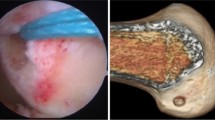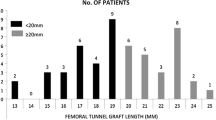Abstract
Purpose
Anatomic tunnel placement in ACL reconstruction is crucial to restore knee function. The aims of this study were to (i) evaluate the accuracy of tunnel placement for primary state-of-the-art ACL reconstruction, and (ii) examine the correlation between incorrect tunnel placement, graft appearance, and notch impingement.
Methods
In this retrospective study, all patients underwent primary single-bundle ACL reconstruction with independent drilling of the femoral and tibial tunnels according to anatomical landmarks. The accuracy of tunnel placement and the rate of notch impingement were analysed with MRI. The study cohort was subdivided according to the morphology of the graft: intact, degeneration, and re-rupture. The objective outcome was evaluated with the IKDC objective score, and the subjective outcomes were evaluated with the IKDC subjective score, the Lysholm knee score, the KOOS, and the Tegner activity scale score.
Results
Eighty-seven consecutive patients with a mean follow-up of 3.8 ± 1.4 years were evaluated. There was no significant difference among the groups concerning the baseline characteristics. The re-rupture rate was 9.2%. The position of the femoral tunnel was correct in 92% of the patients, and the position of the tibial tunnel was correct in 93% of the patients. In the intact group, impingement was not found in any of the cases, whereas the rate of impingement in the degeneration (65%) and re-rupture (80%) groups was significantly higher than that in the intact group (p < 0.001). The risk of impingement was more likely with femoral (71% vs. 13%, p < 0.001) or tibial (100% vs. 11%, p < 0.001) malpositioning. The objective IKDC score was A in 52 patients (60%), B in 26 patients (30%), and C in 9 patients (10%). The average subjective IKDC score, Lysholm score, and KOOS were comparable in the intact and degeneration groups but significantly lower in the patient group with newly diagnosed re-ruptures (p = 0.05). The Tegner activity scale score was comparable in all three groups.
Conclusion
Even though the accuracy of femoral tunnel placement in modern single-bundle ACL reconstruction is greater, the risk of malpositioning and graft impingement remains. In our patient cohort, there was a clear correlation between ACL graft impingement, degenerative changes in MRI, and incorrect tunnel positioning. The surgeon must focus on accurate tunnel placement specific to individual patient anatomy.
Level of evidence
Level III.





Similar content being viewed by others
References
Agneskirchner JD, Galla M, Landwehr P, Lobenhoffer HP (2004) Simplified MRI sequences for postoperative control of hamstring anterior cruciate ligament reconstruction. Arch Orthop Trauma Surg 124:215–220
Bedi A, Maak T, Musahl V, Citak M, O’Loughlin PF, Choi D, Pearle AD (2011) Effect of tibial tunnel position on stability of the knee after anterior cruciate ligament reconstruction: is the tibial tunnel position most important? Am J Sports Med 39:366–373
Bouras T, Fennema P, Burke S, Bosman H (2018) Stenotic intercondylar notch type is correlated with anterior cruciate ligament injury in female patients using magnetic resonance imaging. Knee Surg Sports Traumatol Arthrosc 26:1252–1257
Brandser EA, Riley MA, Berbaum KS, el-Khoury GY, Bennett DL, (1996) MR imaging of anterior cruciate ligament injury: independent value of primary and secondary signs. AJR Am J Roentgenol 167:121–126
Buzzi R, Zaccherotti G, Giron F, Aglietti P (1999) The relationship between the intercondylar roof and the tibial plateau with the knee in extension: relevance for tibial tunnel placement in anterior cruciate ligament reconstruction. Arthroscopy 15:625–631
Cha J-R, Lee C-C, Cho S-D, Youm Y-S, Jung K-H (2013) Symptomatic mucoid degeneration of the anterior cruciate ligament. Knee Surg Sports Traumatol Arthrosc 21:658–663
van Eck CF, Gravare-Silbernagel K, Samuelsson K, Musahl V, van Dijk CN, Karlsson J, Irrgang JJ, Fu FH (2013) Evidence to support the interpretation and use of the Anatomic Anterior Cruciate Ligament Reconstruction Checklist. J Bone Joint Surg Am 95:e153
van Eck CF, Schreiber VM, Mejia HA, Samuelsson K, van Dijk CN, Karlsson J, Fu FH (2010) “Anatomic” anterior cruciate ligament reconstruction: a systematic review of surgical techniques and reporting of surgical data. Arthroscopy 26:S2–12
Fink C, Smigielski R, Siebold R, Abermann E, Herbort M (2020) Anterior Cruciate Ligament Reconstruction Using a Ribbon-Like Graft With a C-Shaped Tibial Bone Tunnel. Arthrosc Tech 9:e247–e262
Fu FH, van Eck CF, Tashman S, Irrgang JJ, Moreland MS (2015) Anatomic anterior cruciate ligament reconstruction: a changing paradigm. Knee Surg Sports Traumatol Arthrosc 23:640–648
Goss BC, Howell SM, Hull ML (1998) Quadriceps load aggravates and roofplasty mitigates active impingement of anterior cruciate ligament grafts against the intercondylar roof. J Orthop Res 16:611–617
Goss BC, Hull ML, Howell SM (1997) Contact pressure and tension in anterior cruciate ligament grafts subjected to roof impingement during passive extension. J Orthop Res 15:263–268
Grassi A, Bailey JR, Signorelli C, Carbone G, Tchonang Wakam A, Lucidi GA, Zaffagnini S (2016) Magnetic resonance imaging after anterior cruciate ligament reconstruction: A practical guide. World J Orthop 7:638–649
Harner CD, Honkamp NJ, Ranawat AS (2008) Anteromedial portal technique for creating the anterior cruciate ligament femoral tunnel. Arthroscopy 24:113–115
Harner CD, Marks PH, Fu FH, Irrgang JJ, Silby MB, Mengato R (1994) Anterior cruciate ligament reconstruction: endoscopic versus two-incision technique. Arthroscopy 10:502–512
Hart A, Sivakumaran T, Burman M, Powell T, Martineau PA (2018) A Prospective Evaluation of Femoral Tunnel Placement for Anatomic Anterior Cruciate Ligament Reconstruction Using 3-Dimensional Magnetic Resonance Imaging. Am J Sports Med 46:192–199
Hosseini A, Lodhia P, Van de Velde SK, Asnis PD, Zarins B, Gill TJ, Li G (2012) Tunnel position and graft orientation in failed anterior cruciate ligament reconstruction: a clinical and imaging analysis. Int Orthop 36:845–852
Howell SM (1998) Principles for placing the tibial tunnel and avoiding roof impingement during reconstruction of a torn anterior cruciate ligament. Knee Surg Sports Traumatol Arthrosc 1:S49–55
Howell SM, Barad SJ (1995) Knee extension and its relationship to the slope of the intercondylar roof. Implications for positioning the tibial tunnel in anterior cruciate ligament reconstructions. Am J Sports Med 23:288–294
Howell SM, Taylor MA (1993) Failure of reconstruction of the anterior cruciate ligament due to impingement by the intercondylar roof. J Bone Joint Surg Am 75:1044–1055
Huang M, Li Y, Guo N, Liao C, Yu B (2019) Relationship between intercondylar notch angle and anterior cruciate ligament injury: a magnetic resonance imaging analysis. J Int Med Res 47:1602–1609
Inderhaug E, Raknes S, Østvold T, Solheim E, Strand T (2017) Increased revision rate with posterior tibial tunnel placement after using the 70-degree tibial guide in ACL reconstruction. Knee Surg Sports Traumatol Arthrosc 25:152–158
Iriuchishima T, Shirakura K, Fu FH (2013) Graft impingement in anterior cruciate ligament reconstruction. Knee Surg Sports Traumatol Arthrosc 21:664–670
Iriuchishima T, Tajima G, Ingham SJM, Shen W, Smolinski P, Fu FH (2010) Impingement pressure in the anatomical and nonanatomical anterior cruciate ligament reconstruction: a cadaver study. Am J Sports Med 38:1611–1617
Jamsher M, Ballarati C, Viganò M, Hofbauer M, Togninalli D, Lafranchi S, de Girolamo L, Denti M (2019) Graft Inclination Angles in Anterior Cruciate Ligament Reconstruction Vary Depending on Femoral Tunnel Reaming Method: Comparison Among Transtibial, Anteromedial Portal, and Outside-In Retrograde Drilling Techniques. Arthroscopy 36(4):1095–1102
Kopf S, Forsythe B, Wong AK, Tashman S, Anderst W, Irrgang JJ, Fu FH (2010) Nonanatomic tunnel position in traditional transtibial single-bundle anterior cruciate ligament reconstruction evaluated by three-dimensional computed tomography. J Bone Joint Surg Am 92:1427–1431
Kosy JD, Mandalia VI (2018) Plain radiographs can be used for routine assessment of ACL reconstruction tunnel position with three-dimensional imaging reserved for research and revision surgery. Knee Surg Sports Traumatol Arthrosc 26:534–549
Lobenhoffer P, Bernard M, Agneskirchner J (2003) Qualitätssicherung in der Kreuzbandchirurgie. Arthroskopie 16:202–208
Lubowitz JH, Amhad CH, Anderson K (2011) All-Inside Anterior Cruciate Ligament Graft-Link Technique: Second-Generation, No-Incision Anterior Cruciate Ligament Reconstruction. Arthroscopy 27:717–727
Mao Y, Marshall B, Price T, Linde M, Smolinski P, Fu FH, van Eck CF (2020) Notchplasty alters knee biomechanics after anatomic ACL reconstruction. Knee Surg Sports Traumatol Arthrosc 28:614–621
Pedneault C, Laverdière C, Hart A, Boily M, Burman M, Martineau PA (2019) Evaluating the Accuracy of Tibial Tunnel Placement After Anatomic Single-Bundle Anterior Cruciate Ligament Reconstruction. Am J Sports Med 47:3187–3194
Robin BN, Jani SS, Marvil SC, Reid JB, Schillhammer CK, Lubowitz JH (2015) Advantages and Disadvantages of Transtibial, Anteromedial Portal, and Outside-In Femoral Tunnel Drilling in Single-Bundle Anterior Cruciate Ligament Reconstruction: A Systematic Review. Arthroscopy 31:1412–1417
Sirleo L, Innocenti M, Innocenti M, Civinini R, Carulli C, Matassi F (2018) Post-operative 3D CT feedback improves accuracy and precision in the learning curve of anatomic ACL femoral tunnel placement. Knee Surg Sports Traumatol Arthrosc 26:468–477
Śmigielski R, Zdanowicz U, Drwięga M, Ciszek B, Williams A (2016) The anatomy of the anterior cruciate ligament and its relevance to the technique of reconstruction. Bone Joint J 98-B:1020–1026
Sullivan JP, Matava MJ, Flanigan DC, Gao Y, Britton CL, Amendola A, MOON Group, Wolf BR (2012) Reliability of tunnel measurements and the quadrant method using fluoroscopic radiographs after anterior cruciate ligament reconstruction. Am J Sports Med 40:2236–2241
Tanksley JA, Werner BC, Conte EJ, Lustenberger DP, Burrus MT, Brockmeier SF, Gwathmey FW, Miller MD (2017) ACL Roof Impingement Revisited: Does the Independent Femoral Drilling Technique Avoid Roof Impingement With Anteriorly Placed Tibial Tunnels? Orthop J Sports Med 5:232596711770415
Thein R, Spitzer E, Doyle J, Khamaisy S, Nawabi DH, Chawla H, Lipman JD, Pearle AD (2016) The ACL Graft Has Different Cross-sectional Dimensions Compared With the Native ACL: Implications for Graft Impingement. Am J Sports Med 44:2097–2105
Van der Bracht H, Bellemans J, Victor J, Verhelst L, Page B, Verdonk P (2014) Can a tibial tunnel in ACL surgery be placed anatomically without impinging on the femoral notch? A risk factor analysis. Knee Surg Sports Traumatol Arthrosc 22:291–297
Yasuda K, van Eck CF, Hoshino Y, Fu FH, Tashman S (2011) Anatomic single- and double-bundle anterior cruciate ligament reconstruction, part 1: Basic science. Am J Sports Med 39:1789–1799
Acknowledgements
The authors would like to thank the AUVA for the funding of the project within the grant ID 9/19. We would like to express our great appreciation to Dr. Wolfgang Huf for his key role in the analysis and interpretation of data. Dr. T. Brüll provided us with very valuable advice and we are particularly grateful for the assistance in the radiological follow-up. Assistance provided by the whole staff of the radiology department was greatly appreciated.
Funding
The study was funded by a Grant (ID 9/19) of the Allgemeine Unfall Versicherungsanstalt (AUVA).
Author information
Authors and Affiliations
Contributions
All authors declare that they have made substantial contributions to conception and design, or acquisition of data, or analysis and interpretation of data. They have been involved in drafting the manuscript or revising it critically for important intellectual content. They have given final approval of the version to be published. They agree to be accountable for all aspects of the work in ensuring that questions related to the accuracy or integrity of any part of the work are appropriately investigated and resolved.
Corresponding author
Ethics declarations
Conflict of interest
All authors declare that they have no conflict of interest.
Ethical approval
Ethical approval was given by the Institutional Review Board of the AUVA, Austria (ID 19/2018).
Informed consent
Written informed consent was obtained from all patients before enrolment.
Additional information
Publisher's Note
Springer Nature remains neutral with regard to jurisdictional claims in published maps and institutional affiliations.
Electronic supplementary material
Below is the link to the electronic supplementary material.
Rights and permissions
About this article
Cite this article
Schützenberger, S., Grabner, S., Schallmayer, D. et al. The risk of graft impingement still exists in modern ACL surgery and correlates with degenerative MRI signal changes. Knee Surg Sports Traumatol Arthrosc 29, 2880–2888 (2021). https://doi.org/10.1007/s00167-020-06300-1
Received:
Accepted:
Published:
Issue Date:
DOI: https://doi.org/10.1007/s00167-020-06300-1




